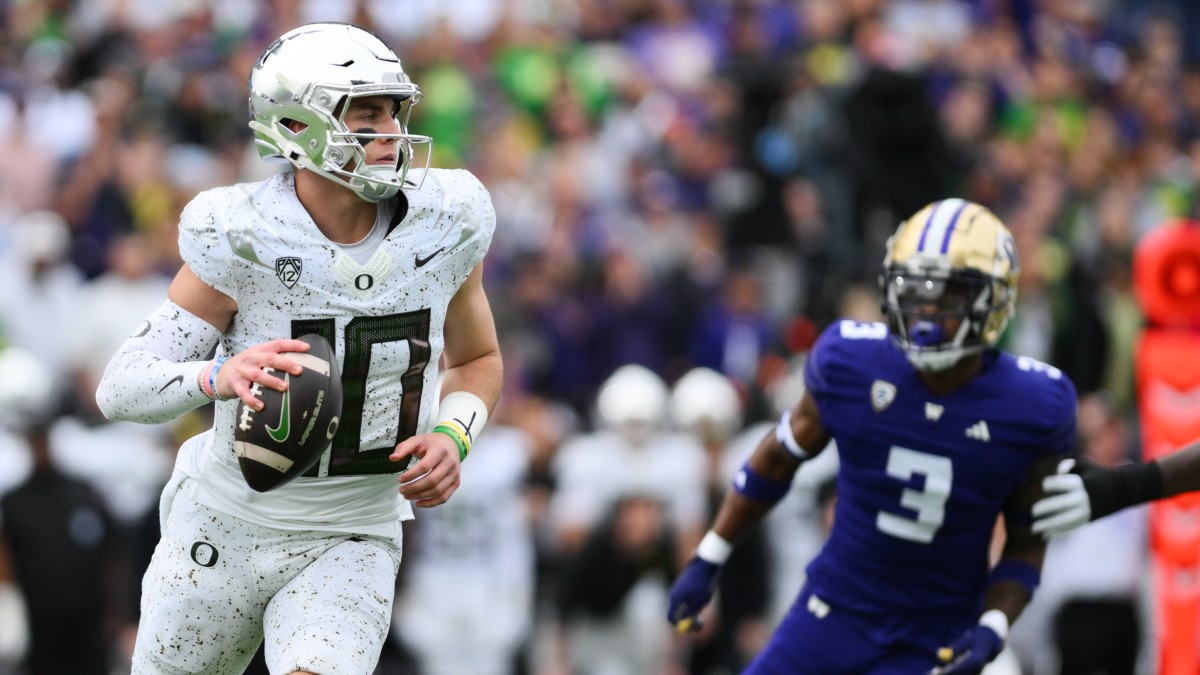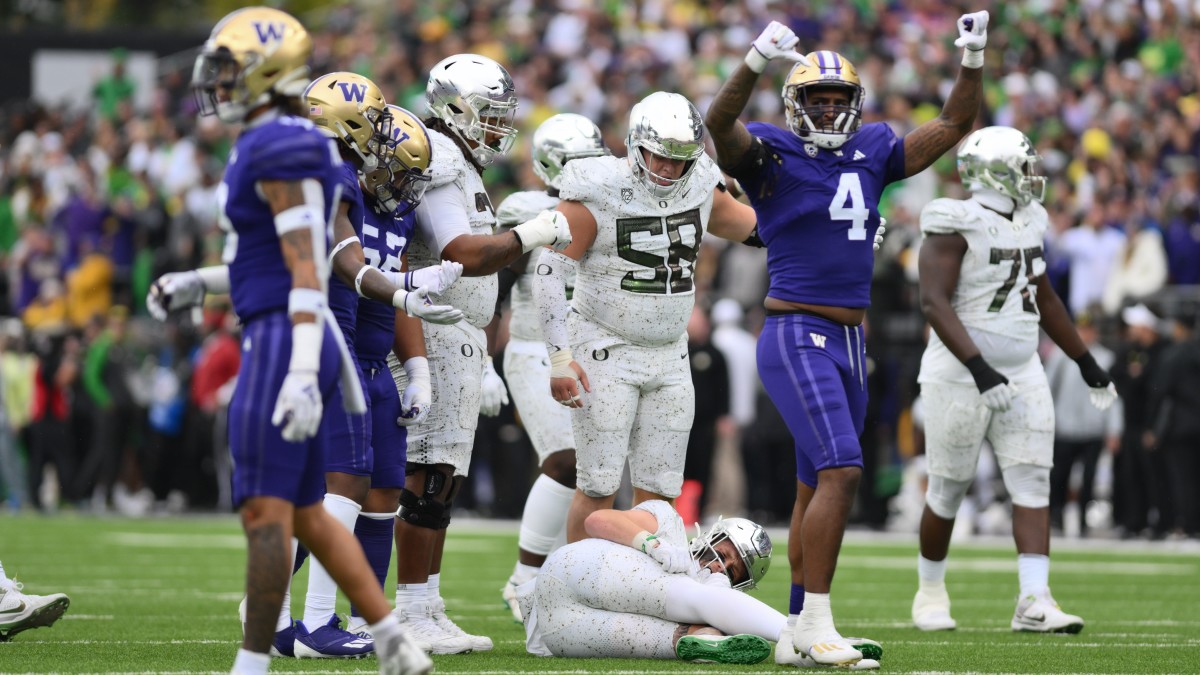Analyzing Oregon's Failed Fourth-Down Attempts in Washington Loss

Every high level player or coach will tell you the process is more important than the results in building a program and attempting to win a game. The problem is that in sports, the results speak louder than the process that led to them. The scoreboard says you win or you lose. The result is a cold binary, even when the process is deeply nuanced.
Consider the fact that Washington is, by multiple measures, perhaps the best offense in college football. That alone means that you have to change the calculus of how you think a game should be managed by a coach when facing the Huskies. But for Oregon’s Dan Lanning, it didn’t, because he’s already aggressive in his fourth-down decision making in an effort to maximize the opportunities at points for his team. When Oregon ran a fake punt with a 300-pound defensive lineman as a ball carrier from their own 17-yard line against Colorado while leading by 13, Lanning was lauded as a wily gambler. When Oregon got stopped on fourth down (as it did against Washington and Oregon State last year) Lanning got crushed as foolhardy for losing the game for his team. Such is the dichotomy of weighing the process against the results—which, in this case, was a 36–33 Huskies win.
While these decisions are not all the same, they speak to Oregon’s aggressive identity. How these decisions play out underscores the fact that merely making the call to go for it or not is not the only factor involved here. Oregon went 0-for-3 on fourth downs against Washington. The decision to go for it all three times does not reflect a poor process, but the Ducks got none of them as a result of their own execution lacking and Washington's defense rising to the task.
With some help from sports consulting firm Championship Analytics founder and president Michael McRoberts, let’s take a peek under the hood to break down what factors caused the results for these three fourth down decisions that ultimately played a huge role in the Ducks’ demise.

Fourth down No. 1
Score: Washington leads, 22–18
Time: 0:06 left in the second quarter
Down-and-distance: Fourth-and-goal from the Washington 3-yard line
The Ducks were actually only in this position after Washington converted on its own fourth-and-1 to extend its final drive of the first half. Two plays later, Michael Penix Jr. threw an interception. Oregon drove into the red zone and had first-and-goal at the 10-yard line and both third- and fourth-and-goal from the three. It opted not to run the ball on any of its four chances. On third down, quarterback Bo Nix rushed an incomplete pass to a receiver that would have gotten at least gotten very close to scoring had it been caught. On fourth down, Oregon ran a sprint out play where Nix rolled to his right—further compressing an already crowded area on the field—and the half ended with a whimper when the pass fell incomplete.
Of the three fourth downs, it’s the one that is most open for criticism—especially given Oregon got the ball coming out of the half.
According to data provided by TruMedia, teams are 49% on fourth down plays from the 3-yard line. Oregon’s elite offense scores 4.8 points per drive, far above average. If you give Oregon 100 plays from the 3-yard line, they will score around 350 points if they go for it every time. If they kick a field goal every time, they’ll likely miss a few and get around 285 points, in McRoberts’s estimation. He considers going for it as the clear winner in a long term strategy sense. You would only need to make about 42% of the plays from three to break even. Oregon’s play here simply didn’t work. And given the three point margin in the final score, it’s hard to ignore that this one ended up being particularly costly in the end.
“It’s hard to pull the trigger from a psychological perspective when, on one hand you’ve got a very likely three (never assume a kick will be made) and if you go for the 7, you’re a coin flip (at best) of getting what you want,” McRoberts said. “You’re going to be walking away empty-handed a good portion of the time going for it, which makes taking the field goal really enticing—even if it’s not the choice that gives you the best shot to win in the long run. Fans and broadcasters are gonna ask why didn’t you just take the three if it fails, and that makes it really hard to make the tough choice to gain an edge.”
Fourth down No. 2
Score: Washington leads, 29–18
Time: 3:37 left in the third quarter
Down-and-distance: Fourth-and-3 from the Washington 8-yard line
The Ducks got this to fourth-and-3 by running the ball on third-and-6, a decision they likely made because they knew they were going to go for it on fourth. Before Oregon ran the play, ESPN’s own graphic on the bottom of the screen said that anything at fourth-and-6 or shorter in that situation was a go-for-it moment.
Nix opted to take a one-on-one matchup to his left and threw a low pass that ended up incomplete. Had he looked elsewhere, receiver Traeshon Holden was wide open in the middle of the field and would have gotten the first down easily with an accurate throw.
It is commonly assumed that eight points is a one possession game, but as we saw in this very game, fourth-and-goal form the 3-yard line (which is the exact distance of a two-point play is) is very much not a given. Oregon even stopped Washington from the 1-yard line on a fourth down at a different moment in the game.

“Down 11 is certainly a two possession game, but down 8 is at least a 50/50 chance of it not being a one-possession game, as a touchdown and two-point conversion is needed to tie,” McRoberts said. “Oregon is really up against it regardless—down 11, about a 15 to 20% chance of winning. Lot more to be gained for a strategy working out at that juncture than lost from something going wrong.”
ESPN gave Oregon about an 18% win probability before the fourth down attempt. But because the Ducks failed, Washington was backed up in the shadow of their own goalpost, and Oregon was able to force a punt.
Oregon got the ball back around at the 50-yard line and scored in three plays, then converted a two-pointer to cut the deficit to three with 1:36 left in the third.
Fourth down No. 3: three yards to gain from the 47-yard line, Oregon up four points, 2:16 left in the game
Score: Oregon leads, 33–29
Time: 2:16 left in the fourth quarter
Down-and-distance: Fourth-and-3 from the Washington 47-yard line
Given the time on the clock and the fact that Washington was without any timeouts, a conversion wins the game here (unless you’re Miami). But McRoberts frames the decision as Oregon actually maximizing its pathways to win by going for it because of the time they had after a quick Washington touchdown.
“Going for it gave them three different doable ways to win: Convert on the fourth down, stop the [ensuing Washington] drive, or get a final score after a Washington touchdown. Punting gives you two options: stop the drive or get a final score. The only edge in punting is that Washington might have to go 80-90 yards for a score instead of 53. Washington certainly wasn’t happy to see the Oregon offense on the field there and would have gladly started their drive 30-40 yards back if they didn’t have to stop that play to avoid defeat. In fact, one advantage of going for it and missing is that that last pathway to winning (Washington scores quickly) is much more likely on a fourth down miss vs. punting. Oregon did have a lot of time for that last drive, as Washington scored really fast, and was a reason why Oregon had the last field goal attempt.”
Even if punting and play defense seems like a good option, increasing your pathways to win is more advantageous. You are trying to gain edges to win a game against a great team. Maybe Oregon gets a coffin-corner punt, but also the punt could have been returned or resulted in a touchback, making the yardage difference of the Huskies starting their game-winning drive at the 45 and around the 20 fairly negligible. Remember, this is Washington. If you assume that the Huskies are more likely to score in this situation than not given the fact that they’re definitely going to use all four downs, then the decision that gives you the best chance to win is the one that keeps that offense off the field entirely.
“We can look back now and say, ‘Hey, you should have punted,’ right?” Lanning said after the game. “If you get the fourth down, the game’s over. They’re an explosive offense. We don’t know if there’s a big difference in them having to go 75 or 50 yards with the ability they have to put the ball down the field. We felt it was more advantageous to close the game out.”
To examine just the three fourth down decisions omits the fact that Oregon also had two more extremely high-leverage situations when it attempted two-point conversions and converted them both. One of them came 10 minutes into the game—and by conventional wisdom was probably too early to chase points—but Oregon stole a point because it got the look in the defense that it wanted and capitalized. If you lump all the decisions together, Oregon went 2-for-5 on high leverage decisions to try and maximize their attempt to win the game.
With the second and third fourth-down attempts, the Ducks were making the best decisions from a long-term perspective and fell into bad outcomes in a small sample size game. That’s football, and just because the result tells a story with a bad ending does not mean that will always be the case—or, more importantly, that the process that used to get there wasn’t sound.
